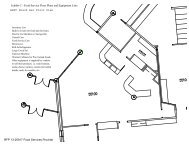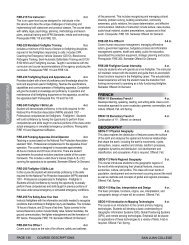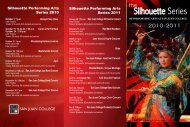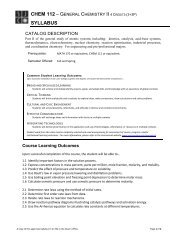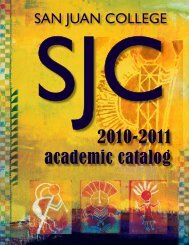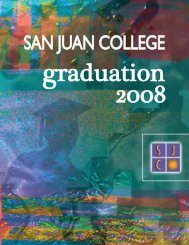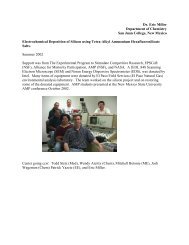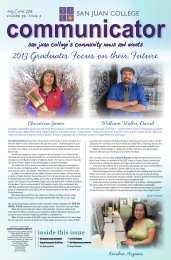AQIP 2007 Systems Portfolio - San Juan College
AQIP 2007 Systems Portfolio - San Juan College
AQIP 2007 Systems Portfolio - San Juan College
You also want an ePaper? Increase the reach of your titles
YUMPU automatically turns print PDFs into web optimized ePapers that Google loves.
<strong>San</strong> <strong>Juan</strong> <strong>College</strong> – <strong>AQIP</strong> <strong>Systems</strong> <strong>Portfolio</strong> – November <strong>2007</strong>culture for innovation, change and growth, anddevelop and provide service learning opportunities.Table 9.1 illustrates the six key areas of collaborativerelationships, the types of relationships and theentities with which SJC shares these collaborations.9C2 Strategic collaborative relationships reinforce<strong>San</strong> <strong>Juan</strong> <strong>College</strong>’s mission, vision and goals “inconcert with other community agencies, businesses,industries and other groups.” Relationships help tiethe real work and thinking processes of innovativeeducational, business, industry and social leaders tothe learning processes.By intentionally pursuing collaborative relationships,<strong>San</strong> <strong>Juan</strong> <strong>College</strong> leverages its resources, allowingthe <strong>College</strong> to expand the quantity and quality of itsofferings to students and to the community at large.Feedback from these collaborative relationshipsprovides the <strong>College</strong> with information on relevancy ofcurriculum, through the advisory councils andcommittees. Environmental scanning involves SJC’spartners in helping to set future direction for the<strong>College</strong> and helps tie the real world of work to thelearning process. Collaborations of educationalinstitutions provide communication among and withinthe levels of public schools, SJC, and HigherEducation, creating a synergy of mutually beneficialpartner activities. For example, the CEPD wascreated to assist the public schools in accessing andsharing professional development opportunities withSJC and the University Programs offering:administrator’s academy training; teacher testing andprofessional development dossier; college anduniversity program marketing; and communication ofactivities. This collaboration has led to anunderstanding of the benefits of sharing resources toenhance available offerings to local educators,improving the quality of education to educators. Inaddition, Career Services, the Testing Center, andBusiness & Industry training are developing apartnership with local business, schools and stateemployment agencies to implement WorkKeys.Partnerships in healthcare provide both practicalexperience to the students in the Health Sciencesprograms, and clinical assistance to local healthcareproviders. For example, the hospitals provide clinicalexperience to the nursing program and a dental clinicis provided under the guidance of local dentalhygienists and a dentist. B & I Training responds tomedical administrative assistant needs, surgicaltechnicians, and other specific requests fromhealthcare providers. Activities provide the studentswith essential practical experience and the communitywith some healthcare support under supervision.The college supports leadership in its activeparticipation in the collaborative relationships andsupport of Leadership <strong>San</strong> <strong>Juan</strong>, the county-wideleadership program and the annual Four CornersProfessional Development Conference. This yearlongprogram opens communication among futureand current leaders, giving opportunity for mutuallearning about both the issues and agencies whoaddress those community concerns. In addition, thecollege participates in the <strong>San</strong> <strong>Juan</strong> SafeCommunities Initiative, provides facilities for countypolice and fire training programs, and benefits throughthe improved safe environment provided to thestudents, employees, and community members.The Family Resource Center and Project Readprovide family and parent support, literacyimprovement tutoring, and improve the quality of lifefor families in <strong>San</strong> <strong>Juan</strong> County. These programsoften provide a first connection to the college, creatinga significant difference in the lives of thoseparticipating, and assist in long-range studentrecruitment and community good-will.<strong>San</strong> <strong>Juan</strong> <strong>College</strong> evaluates its yearly performance onthe basis of collaborative relationships through use ofits Strategic Plan (Valuing Partnerships) and <strong>AQIP</strong>(Building Collaborative Relationships). Partnersprovide resources to programs including expertise increating relevant curriculum and real worldapplication; educational opportunities for continueddegree work through University Programs nototherwise available to place-bound residents;assistance to small business for continuing education;and a multitude of other benefits. The synergy withthe community improves the quality of life of itscitizens and in turn benefits the college.Processes (P)9P1 At this time SJC does not utilize a formal modelto create, prioritize and build collaborativerelationships. Instead it uses an informal processaligned to the annual planning process comprised ofthe following elements:• Scan the environment <strong>San</strong> <strong>Juan</strong> <strong>College</strong> usesenvironmental scanning to identify and adapt tothe changing needs of its stakeholders.Research in the field, dialogue with appropriatebusiness and industry personnel andbenchmarking other institutions assists theadministration and staff to stay current to developappropriate partnerships.• Determine viable collaborative relationships <strong>San</strong><strong>Juan</strong> <strong>College</strong> then approaches potential partnersin the fields identified as being necessary tofeedback and input, and at least one <strong>San</strong> <strong>Juan</strong><strong>College</strong> employee becomes the liaison orchampion for the relationship in order to provideinstitutional support.• Assess greatest needs Each collaborativerelationship is examined in light of the needs ofthe <strong>College</strong> and partner. The college planning<strong>AQIP</strong> Category Nine: Building Collaborative Relationships 77



